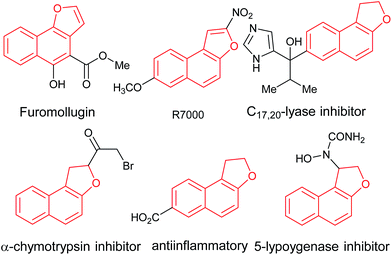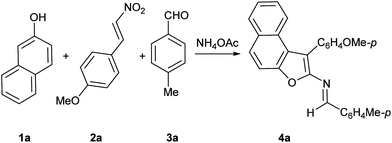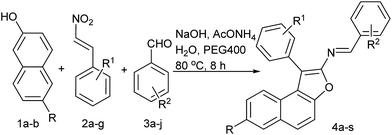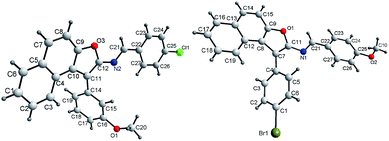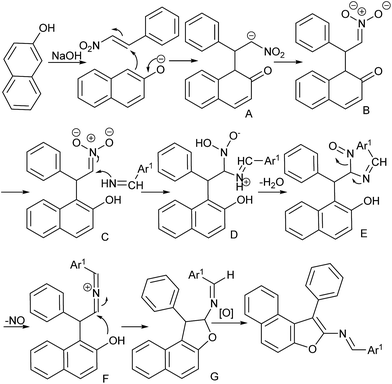Four-component reaction between naphthols, substituted β-nitrostyrenes, substituted benzaldehydes and ammonium acetate in water–PEG-400: an approach to construct polysubstituted naphthofuranamines†
Jungui Zhangab,
Juan Yaoa,
Jiaming Liua,
Shuwen Xuea,
Yang Lia and
Cunde Wang*a
aSchool of Chemistry and Chemical Engineering, Yangzhou University, 180 Siwangting Street, Yangzhou 225002, P. R. China. E-mail: wangcd@yzu.edu.cn; Fax: +86-514-8797-5244; Tel: +86-514-8797-5568
bNew Division: School of Hydraulic, Energy and Power Engineering, Yangzhou University, 180 Siwangting Street, Yangzhou 225002, P. R. China
First published on 26th May 2015
Abstract
An eco-friendly straightforward and efficient one-pot four-component protocol has been developed for the synthesis of naphtho[b]furan scaffolds in water–PEG-400 (6![[thin space (1/6-em)]](https://www.rsc.org/images/entities/char_2009.gif) :
:![[thin space (1/6-em)]](https://www.rsc.org/images/entities/char_2009.gif) 1, v/v) at 80 °C from naphthanols, substituted β-nitrostyrenes, substituted benzaldehydes and ammonium acetate. The new efficient domino reaction formed a furan ring and a Schiff base core by the concomitant formation of C–C, C–O, and C–N multiple bonds presumably involving a sequence of a Michael reaction, aza–ene reaction, imine–enamine/keto–enol tautomerization, O-cyclization and aromatization as key steps.
1, v/v) at 80 °C from naphthanols, substituted β-nitrostyrenes, substituted benzaldehydes and ammonium acetate. The new efficient domino reaction formed a furan ring and a Schiff base core by the concomitant formation of C–C, C–O, and C–N multiple bonds presumably involving a sequence of a Michael reaction, aza–ene reaction, imine–enamine/keto–enol tautomerization, O-cyclization and aromatization as key steps.
Naphthofurans are ubiquitous structural subunits in natural products, synthetic pharmaceuticals, and a broad variety of bioactive molecules.1 Recently, naphthofurans have attracted more attention, and numerous naphthofuran derivatives have been investigated extensively as highly potent inhibitory kappa-β kinase inhibitors,2 nicotinic acetylcholine receptor agonists,3 hepatocyte nuclear factor 4 alpha inhibitors,4 regulators of the nuclear receptor HNF4R,5 imaging agents for β-amyloid plaques in the brain,6 potential anticancer agents,7,1a antimicrobial agents,8 anti-inflammatory agents,9 anti-diabetic agents,10 and analgesic active agents.11 Due to the biological importance and synthetic utility, a lot of methods for the construction of naphthofurans have been developed. Traditionally, the classical preparation of the naphthofuran derivatives utilized the Williamson reaction/intramolecular Aldol reaction of 1-acyl naphthols or 2-acyl naphthols with α-halo ketones or esters, followed by dehydrative cyclization of the acyl ether intermediate.12 The naphthofuran derivatives were also synthesized via the intramolecular Friedel–Crafts reaction of appropriate naphthoxy ketones prepared from α- or β-naphthols and α-halo ketone,13 via the novel Friedel–Crafts alkylation/annulations cascade reaction from 2-naphthols and chalcone epoxides,14 or Friedel–Crafts/oxa-Michael/aromatic annulation of naphthols with nitroallylic acetates.15 Recently improved protocol involved the Michael addition of tertiary enaminoketones or β-ketoesters to naphthoquinones,16 In addition to the conventional naphthofuran synthesis, there were also methods via transition metal-promoted reactions for the preparation of the naphthofuran derivatives, such as Pd(II)-catalyzed intramolecular addition of arylboronic acids to ketones,17 Ru(III)-mediated C- and O-allyl isomerization followed by ring-closing metathesis from the substituted 1-allyl-2-allyloxybenzenes,18 Pt(II)-catalyzed intramolecular coupling reaction of alkynes with furans,19 In(III)-catalyzed Friedel–Crafts/Williamson reaction of naphthols,20 Cu(I) catalyzed intramolecular aldehyde/yne cyclization of 3-(1-alkenyl)-2-alkene-1-al,21 Fe(III)-catalyzed intramolecular hydroaryloxylation of 2-propargyl naphthols,22 W(CO)5-catalyzed electrocyclization reaction of substituted aromatic enynes,23 TiCl4 assisted rearrangement of allyl naphthyl ethers.24 Additionally, several other effective approaches have also been used for the synthesis of naphthofuran derivatives such as intramolecular cyclization of α-styrylnaphthols,25 Michael addition/cyclization of phenolic Mannich bases and pyridinium ylides,26 IBX assisted the oxidization of 2-(naphthalen-6-yloxy)ethanol followed intramolecular cyclization,27 and via one-pot addition reaction of naphthols, aldehydes, and isocyanides under an argon atmosphere and solvent-free conditions.28 However, most of these methods lacked generality and involved multistep reactions from commercially available starting materials. To address this problem, further development of novel and efficient methods for the preparation of naphthofurans with various structural features and substitution patterns, especially those containing nitrogen groups is highly desirable. During our studies on the Michael addition mediated transformations of β-nitrostyrenes,29 we have demonstrated that β-nitrostyrenes is a highly efficient building block for the Michael addition/nitro-Mannich/lactamization cascade reactions between β-nitrostyrenes, aromatic aldehydes, dialkyl malonates or Meldrum's acid, and ammonium acetate or formamide to construct complex polysubstituted piperidines29b,29c,29d and for the novel Michael addition/aza-nucleophilic addition/annulations cascade reaction between substituted β-nitrostyrenes, aromatic aldehydes, ammonium acetate, and cyclohexane-1,3-diones or coumarins to construct polysubstituted benzo[b]furans and furo[3,2-c]chromens.29e,29f
Recent years more and more investigations found that water as a good reaction medium was used for various organic reactions.30 In water as a solvent, the design of new MCRs has attracted numerous attention,31 especially in the areas of drug discovery, and material science.32 Additionally, because polyethylene glycol (PEG) possesses low toxicity and solubility in both aqueous and non-aqueous media,33 it is advantageous over toxic organic solvents, which is a greener alternative in various organic transformations. Several reports have used water as a solvent in the presence of PEG for organic reactions.34 To the best of our knowledge, no example using one-pot multi-component reactions of substituted β-nitrostyrenes, naphthols, substituted benzaldehydes and ammonium acetate in water–PEG to construct the naphtho[b]furan core were reported. These products were described as potent anticancer agents, anti-inflammatory, antimalarial agents, and biologically active natural compound Furomollugin as shown in Fig. 1.35
Encouraged by the illustrated biological and synthetic interest in 1-arylnaphtho[b]furan-2-amines and prompted by the recent results for the combination of MCRs and water as a solvent, we envisaged a novel synthetic pathway to N-benzylidenearylnaphtho[b]furan-2-amines starting from naphthols (1), substituted nitrostyrenes (2), substituted benzaldehydes (3), and ammonium acetate. Herein we report a facile and straightforward method to synthesize polysubstituted naphtho[b]furan Schiff bases from substituted β-nitrostyrenes, naphthols, substituted benzaldehydes and ammonium acetate via one-pot four-component reactions in water–PEG-400.
Initially, based on our more recent results,29a we examined the reaction of β-naphthol (1a), 1-methoxy-4-(2-nitrovinyl)benzene (2a), p-methylbenzaldehyde (3a) with ammonium acetate in EtOH using piperidine as a promoter, but the desired product was not obtained (Table 1, entry 1). Next the replacement of piperidine and EtOH by trimethylamine and DMF also did not give the desired product (Table 1, entry 2).29 Then the solvent DMF was replaced with EtOH or MeOH for the reaction under the same condition, no reaction still occurred (Table 1, entries 3 and 4). Considering the naphthalen-2-olate easily generated from β-naphthol with strong inorganic base such as NaOH for the electrophilic attack of β-nitrostyrene, the mixture of β-naphthol (1a), 1-methoxy-4-(2-nitrovinyl)benzene (2a), p-methylbenzaldehyde (3a), NH4OAc with NaOH in EtOH was stirred at 8 h and refluxed at 16 h, pleasingly, the desired product 4a was obtained in 17% yield (Table 1, entry 5). Next, switching the solvent to water, we performed the model reaction at 80 °C under similar conditions, which afforded the desired product 4a in 32% yield (Table 1, entry 6). Although the yield of 4a was slightly improved, starting materials still encountered a solubility problem. Reconsidering that low molecule polyethylene glycol (PEG) could promote to solubilize organic components in water as a water soluble polyether, in order to make the reaction more efficient, we investigated the model reaction in various molecule PEG and water (1/6, v/v) at 80 °C, and to our delight the desired product was obtained in 35%, 65%, 64% yield within 10 h, respectively (Table 1, entries 7–9). Encouraged by the above result, we carried out the reaction by changing amount of NaOH in a mixture of PEG-400 and H2O (1![[thin space (1/6-em)]](https://www.rsc.org/images/entities/char_2009.gif) :
:![[thin space (1/6-em)]](https://www.rsc.org/images/entities/char_2009.gif) 6), using 2 equivalents NaOH afforded the desired product in 72% yield (Table 1, entry 10), and to our delight the yield of the desired product 4a was obviously improved and the reaction time was shorted to 8 h. Further increase of the amount of NaOH had no significant beneficial effect on the reaction (Table 1, entry 11). The ratio 7
6), using 2 equivalents NaOH afforded the desired product in 72% yield (Table 1, entry 10), and to our delight the yield of the desired product 4a was obviously improved and the reaction time was shorted to 8 h. Further increase of the amount of NaOH had no significant beneficial effect on the reaction (Table 1, entry 11). The ratio 7![[thin space (1/6-em)]](https://www.rsc.org/images/entities/char_2009.gif) :
:![[thin space (1/6-em)]](https://www.rsc.org/images/entities/char_2009.gif) 1 of water–PEG-400 was tested for the title reaction, the result showed that part of the starting materials did not dissolve in the mixture solvent, only afforded the desired product in 57% yield (Table 1, entry 12). Replacing NaOH with KOH led to similar yield of product 4a (Table 1, entry 13).
1 of water–PEG-400 was tested for the title reaction, the result showed that part of the starting materials did not dissolve in the mixture solvent, only afforded the desired product in 57% yield (Table 1, entry 12). Replacing NaOH with KOH led to similar yield of product 4a (Table 1, entry 13).
| Entry | Base | Solvent (V/V) | T (°C) | T (h) | Yieldb (%) |
|---|---|---|---|---|---|
| a Reaction conditions: 3 mmol 2a, 1a/2a/3a/NH4OAc = 1.5/1/1/1 eq., 15 mL solvent, H2O–PEG (6/1, V/V).b Yields were isolated.c 1a/2a/3a/NH4OAc = 1.5/1/1/2 eq.d 1a/2a/3a/NH4OAc = 1.5/1/1/2.5 eq.e The mixture of 3a/NH4OAc was stirred for 30 min firstly, then the reaction was carried out by above conditions. | |||||
| 1 | Piperidine (1 eq.) | EtOH | Reflux | 24 | 0 |
| 2 | Et3N (1 eq.) | DMF | Reflux | 24 | 0 |
| 3 | Et3N (1 eq.) | EtOH | Reflux | 24 | 0 |
| 4 | Et3N (1 eq.) | MeOH | Reflux | 24 | 0 |
| 5 | NaOH (1 eq.) | EtOH | Reflux | 24 | 17 |
| 6 | NaOH (1 eq.) | H2O | 80 | 10 | 32 |
| 7 | NaOH (1 eq.) | H2O–PEG-200 (6/1) | 80 | 10 | 35 |
| 8 | NaOH (1 eq.) | H2O–PEG-400 (6/1) | 80 | 10 | 65 |
| 9 | NaOH (1 eq.) | H2O–PEG-600 (6/1) | 80 | 10 | 64 |
| 10 | NaOH (2 eq.) | H2O–PEG-400 (6/1) | 80 | 8 | 78 |
| 11 | NaOH (3 eq.) | H2O–PEG-400 (6/1) | 80 | 8 | 73 |
| 12 | NaOH (2 eq.) | H2O–PEG-400 (7/1) | 80 | 8 | 57 |
| 13 | KOH (2 eq.) | H2O–PEG-400 (6/1) | 80 | 8 | 70 |
| 14 | NaOH (2 eq.) | H2O–PEG-400 (6/1) | 80 | 8 | 80c |
| 15 | NaOH (2 eq.) | H2O–PEG-400 (6/1) | 80 | 8 | 79d |
| 16 | NaOH (2 eq.) | H2O–PEG-400 (6/1) | 80 | 8 | 86c,e |
Further experiments revealed that the ratio of starting materials as 1a/2a/3a/NH4OAc = 1.5/1/1/2 eq. was confirmed to be the most effective ratio (Table 1, entries 14 and 15). When the mixture of 3a/NH4OAc was stirred for 30 min firstly, then the reaction was carried out by above conditions to give the best yield (Table 1, entry 16). A series of experiments revealed that the optimal results were obtained when the reaction of 1.5 equivalents β-naphthol (1a), 1 equivalent 1-methoxy-4-(2-nitrovinyl)benzene (2a), 1 equivalent p-methylbenzaldehyde (3a), 2 equivalent NH4OAc together with 2 equivalent NaOH was carried out in a mixture of PEG-400 and H2O (1![[thin space (1/6-em)]](https://www.rsc.org/images/entities/char_2009.gif) :
:![[thin space (1/6-em)]](https://www.rsc.org/images/entities/char_2009.gif) 6, v/v), the resultant mixture was stirred for 8 h at 80 °C, whereby the yield of 4a reached 86% (Table 1, entry 14).
6, v/v), the resultant mixture was stirred for 8 h at 80 °C, whereby the yield of 4a reached 86% (Table 1, entry 14).
Having established the optimal conditions for the synthesis of polysubstituted naphtho[2,1-b]furan 4a, to determine the scope of the protocol, a number of available β-naphthols and substituted β-nitrostyrenes were condensed with substituted benzaldehydes and ammonium acetate under optimized reaction condition. The results were summarized in Table 2.
| Entry | R | R1 | R2 | Yielda (%) |
|---|---|---|---|---|
| a Isolated yield.b Thiophene-3-carbaldehyde. | ||||
| 1 | H | p-MeO | p-Me | 86 (4a) |
| 2 | H | m-MeO | p-Cl | 83 (4b) |
| 3 | H | p-Br | m-Br | 50 (4c) |
| 4 | H | p-Br | p-Me | 77 (4d) |
| 5 | Br | p-Me | o-Cl | 76 (4e) |
| 6 | H | p-Br | p-MeO | 80 (4f) |
| 7 | Br | p-Me | p-Me | 55 (4g) |
| 8 | H | p-Cl | o-MeO | 78 (4h) |
| 9 | H | p-Cl | p-Me | 82 (4i) |
| 10 | H | p-NO2 | p-MeO | 56 (4j) |
| 11 | H | p-MeO | o-Cl | 75 (4k) |
| 12 | Br | p-Cl | 3-Phenoxy | 83 (4l) |
| 13 | H | p-MeO | p-MeO | 88 (4m) |
| 14 | H | p-MeO | 3-Thiopheneb | 76 (4n) |
| 15 | H | p-Br | 4-F-3-PhO | 87 (4o) |
| 16 | H | p-Cl | m-PhO | 86 (4p) |
| 17 | H | p-Cl | m-MeO | 58 (4q) |
| 18 | Br | p-Cl | m-Br | 54 (4r) |
| 19 | Br | m-MeO | p-Me | 65 (4s) |
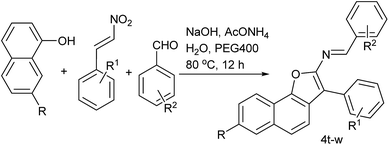 |
||||
| 20 | H | p-Br | o-MeO | 38 (4t) |
| 21 | H | p-Br | p-Me | 45 (4u) |
| 22 | H | p-Me | p-MeO | 55 (4v) |
| 23 | H | p-MeO | p-Br | 50 (4w) |
| 24 | H | p-Cl | p-Br | 44 (4x) |
The reaction tolerates different substituents on the aromatic ring of the naphthanols, substituted β-nitrostyrenes and substituted benzaldehydes, generally, β-nitrostyrenes and substituted benzaldehydes with a range of substituents such as methyl, phenoxyl, methoxy, halo and nitro at ortho-, meta- or para-positions of phenyl groups all worked well to give polysubstituted naphtho[2,1-b]furan Schiff base derivatives. Various β-nitrostyrenes and substituted benzaldehydes possessing substituents of electron-donating groups afforded the corresponding naphtho[2,1-b]furan products in good to excellent yields. Substrates with para-position phenyl groups gave the products in higher yields than those with ortho-, or meta-position phenyl groups. The electronic properties of the substituents on the benzene ring of substituted benzaldehydes had a slight effect on the reaction. The introduction of an electron-withdrawing group such as NO2 or Br speeded down the reaction and decreased the yield of product, thus various substituents should facilitate the synthesis of diversely polysubstituted naphtho[2,1-b]furan Schiff base derivatives. However, we found that the replacement of β-naphthalenol with α-naphthalenol gave the polysubstituted naphtho[1,2-b]furan Schiff base derivatives in slight lower yields, and a longer reaction time was required (Table 2, entries 20–24). In the presence of NaOH, β-naphthalenol was changed to β-naphthalenol anion, followed transferring to carbon anion by keto–enol tautomerism for attacking β-nitrostyrenes more easily than α-naphthalenol. All corresponding products were analyzed by their 1H NMR, 13C NMR and MS. Characteristic 1H chemical shift of naphtho[b]furan Schiff base N![[double bond, length as m-dash]](https://www.rsc.org/images/entities/char_e001.gif) CHAr at δ ca. 9.00 (s). Additionally, the structures of naphtho[2,1-b]furan Schiff base 4b and 4f were unambiguously solved by X-ray crystallography (Fig. 2).36 X-ray crystallographic analysis determined that product 4b and 4f possess a naphtho[b]furan core, an aryl and an arylimine contiguous substituents at C(1) and C(2) of naphtho[2,1-b]furan. On the basis of spectroscopic evidence the structures of compound 4a–s were identified as 1-aryl-2-arylideneamino naphtho[2,1-b]furan.
CHAr at δ ca. 9.00 (s). Additionally, the structures of naphtho[2,1-b]furan Schiff base 4b and 4f were unambiguously solved by X-ray crystallography (Fig. 2).36 X-ray crystallographic analysis determined that product 4b and 4f possess a naphtho[b]furan core, an aryl and an arylimine contiguous substituents at C(1) and C(2) of naphtho[2,1-b]furan. On the basis of spectroscopic evidence the structures of compound 4a–s were identified as 1-aryl-2-arylideneamino naphtho[2,1-b]furan.
The mechanism of this process can be rationalized as a sequence of reactions starting from the initial anion of the starting naphthalen-2-ol. The base-catalyzed Michael reaction between the naphthalen-2-olate anion and the β-nitrostyrene affords the corresponding intermediate carbanion [A]. Then, the carbanion [A] is transferred via the keto–enol tautomerism to an intermediate oxido oxime [B], the following forming an intermediate [C], which then reacts with arylimine generated from aromatic aldehyde and ammonium acetate to give intermediate [D]. Then dehydration of intermediate [D] gives a nitroso imine intermediate [E], Conversion of the intermediate [E] to an intermediate [F] takes place via removal of nitroso group, a final cyclocondensation affords intermediate [G].37 Finally, aromatization of the intermediate [G] yields the corresponding polysubstituted naphtho[2,1-b]furan with a Schiff base (Scheme 1).
In summary, we have developed an eco-friendly straightforward and efficient one-pot four-component protocol for the synthesis of naphtho[2,1-b]furan and naphtho[1,2-b]furan scaffolds in water–PEG-400 (6![[thin space (1/6-em)]](https://www.rsc.org/images/entities/char_2009.gif) :
:![[thin space (1/6-em)]](https://www.rsc.org/images/entities/char_2009.gif) 1; v/v) at 80 °C from naphthanols, substituted β-nitrostyrenes, substituted benzaldehydes and ammonium acetate. The new efficient domino protocol generated a furan ring and a Schiff base core by the concomitant formation of C–C, C–O, and C–N multiple bonds presumably involving a sequence of Michael reaction, aza–ene reaction, imine–enamine/keto–enol tautomerization, O-cyclization and aromatization as key steps. The merit of this method was highlighted by its broad substrate scope and excellent functionality tolerance, operational simplicity and simple workup procedure, which enabled the rapid assembly of diverse naphtho[b]furan frameworks utilizing all the four reactants efficiently for the generation of a wide range of structurally interesting and pharmacologically significant compounds. We expect that the resulting biologically intriguing structures will have broad applications in both synthetic and medicinal researches.
1; v/v) at 80 °C from naphthanols, substituted β-nitrostyrenes, substituted benzaldehydes and ammonium acetate. The new efficient domino protocol generated a furan ring and a Schiff base core by the concomitant formation of C–C, C–O, and C–N multiple bonds presumably involving a sequence of Michael reaction, aza–ene reaction, imine–enamine/keto–enol tautomerization, O-cyclization and aromatization as key steps. The merit of this method was highlighted by its broad substrate scope and excellent functionality tolerance, operational simplicity and simple workup procedure, which enabled the rapid assembly of diverse naphtho[b]furan frameworks utilizing all the four reactants efficiently for the generation of a wide range of structurally interesting and pharmacologically significant compounds. We expect that the resulting biologically intriguing structures will have broad applications in both synthetic and medicinal researches.
Acknowledgements
This work was supported by generous grants from the National Natural Science Foundation of China (NNSFC 21173181). A Project Funded by the Priority Academic Program Development of Jiangsu Higher Education Institutions.Notes and references
- (a) M. N. Venkata, S. Claessens, P. Habonimana and N. D. Kimpe, J. Org. Chem., 2010, 75, 2274 CrossRef PubMed; (b) J.-P. Lumb, K. C. Choong and D. Trauner, J. Am. Chem. Soc., 2008, 130, 9230 CrossRef CAS PubMed; (c) L.-K. Ho, M.-J. Don, H.-C. Chen, S.-F. Yeh and J.-M. Chen, J. Nat. Prod., 1996, 59, 330 CrossRef CAS PubMed; (d) V. Srivastava, A. S. Negi, J. K. Kumar, U. Faridi, B. S. Sisodia, M. P. Darokar, S. Luqman and S. P. S. Khanuja, Bioorg. Med. Chem. Lett., 2006, 16, 911 CrossRef CAS PubMed; (e) A. K. Debnath, C. Hansch and K. H. Kim, J. Med. Chem., 1993, 36, 1007 CrossRef CAS; (f) K. Inoue, S. Ueda, H. Nayeshiro and H. Inouye, Phytochemistry, 1982, 22, 737 CrossRef; (g) H. Hagiwara, K. Sato, T. Suzuki and M. Ando, Heterocycles, 1999, 51, 497 CrossRef CAS; (h) A. Arrault, Synthesis, 1999, 1241 CrossRef CAS PubMed; (i) M. Adib, M. Mahdavi, S. Bagherzadeh and H. Bijanzadeh, Synlett, 2009, 2542 CrossRef CAS PubMed; (j) A. H. F. A. El-Wahab, Z. I. A. Al-Fifi, A. H. Bedair, F. M. Ali, A. H. A. Halawa and A. M. El-Agrody, Molecules, 2011, 16, 307 CrossRef PubMed; (k) C. Pan, J. Yu, Y. Zhou, Z. Wang and M.-M. Zhou, Synlett, 2006, 1657 CAS; (l) X. Guo, R. Yu, H. Li and Z. Li, J. Am. Chem. Soc., 2009, 131, 17387 CrossRef CAS PubMed; (m) J.-Y. Yeh, M. S. Coumar, J.-T. Horng, H.-Y. Shiao, F.-M. Kuo, H.-L. Lee, I.-C. Chen, C.-W. Chang, W.-F. Tang, S.-N. Tseng, C.-J. Chen, S.-R. Shih, J. T. Hsu, C.-C. Liao, Y.-S. Chao and H.-P. Hsieh, J. Med. Chem., 2010, 53, 1519 CrossRef CAS PubMed; (n) N. Durani, R. Jain, A. Saeed and D. Dikshit, J. Med. Chem., 1989, 32, 1700 CrossRef CAS; (o) V. Srivastava, A. S. Negi, J. K. Kumar, U. Faridi, B. S. Sisodia, M. P. Darokar, S. Luqman and S. P. S. Khanuja, Bioorg. Med. Chem. Lett., 2006, 16, 911 CrossRef CAS PubMed; (p) S. Ye, G. Liu, S. Pu and J. Wu, Org. Lett., 2011, 14, 70 CrossRef PubMed; (q) M. J. Moure, R. SanMartin and E. Dominguez, Angew. Chem., Int. Ed., 2012, 51, 3220 CrossRef CAS PubMed; (r) N. Sakiyama, K. Noguchi and K. Tanaka, Angew. Chem., Int. Ed., 2012, 51, 5976 CrossRef CAS PubMed; (s) K. C. Nicolaou, S. A. Snyder, A. Bigot and J. A. Pfefferkorn, Angew. Chem., Int. Ed., 2000, 39, 1093 CrossRef CAS; (t) A. S. K. Hashmi, W. Yang and F. Rominger, Angew. Chem., Int. Ed., 2011, 50, 5762 CrossRef CAS PubMed; (u) A. S. K. Hashmi, W. Yang and F. Rominger, Chem.–Eur. J., 2012, 18, 6576 CrossRef CAS PubMed.
- Y. Ikeura, M. Yoshida and H. Sugiyama, WO2006/036031, 2006.
- M. Hendrix, F.-G. Bob, C. Erb, T. Flebner, M. Van Kampen, J. Luithle, C. Methfessel and B. W. Wiese, WO2003/055878, 2003.
- R. L. Guével, F. Oger, A. Lecorgne, Z. Dudasova, S. Chevance, A. Bondon, P. Barath, G. Simonneaux and G. Salbert, Bioorg. Med. Chem. Lett., 2009, 17, 7021 CrossRef PubMed.
- R. LeGuevel, F. Oger, A. Lecorgne, Z. Dudasova, S. Chevance, A. Bondon, P. Barath, G. Simonneaux and G. Salbert, Bioorg. Med. Chem., 2009, 17, 7021 CrossRef CAS PubMed.
- C.-S. Gan, D.-D. Nan, J.-P. Qiao, C.-W. Wang and J.-N. Zhou, J. Nucl. Med., 2012, 53, 1620 Search PubMed.
- V. Srivastava, A. S. Negi, J. K. Kumar, U. Faridi, B. S. Sisodia, M. P. Darokar, S. Luqman and S. P. S. Khanuja, Bioorg. Med. Chem. Lett., 2006, 16, 911 CrossRef CAS PubMed.
- C. H. Chandrashekhar, K. P. Latha, H. M. Vagdevi and V. P. Vaidya, Der Pharma Chem., 2011, 3, 329 CAS.
- C.-H. Tseng, C.-S. Lin, P.-K. Shih, L.-T. Tsao, J.-P. Wang, C.-M. Cheng, C.-C. Tzeng and Y.-L. Chen, Bioorg. Med. Chem. Lett., 2009, 17, 6773 CrossRef CAS PubMed.
- M. Paal, G. Ruehter, T. Schotten and W. Stenzel, WO2000/078726, 2000.
- K. Shashikala Devi, M. Ramaiah, G. K. Vanita, K. Veena and V. P. Vaidya, J. Chem. Pharm. Res., 2011, 3, 445 CAS.
- (a) K. K. Park and J. Jeong, Tetrahedron, 2005, 61, 545 CrossRef CAS PubMed; (b) J. Y. Yeh, M. S. Coumar, J. T. Horng, H. Y. Shiao, F. M. Kuo, H. L. Lee, I. C. Chen, C. W. Chang, W. F. Tang, S. N. Tseng, C. J. Chen, S. R. Shih, J. T. A. Hsu, C. C. Liao, Y. S. Chao and H. P. Hsieh, J. Med. Chem., 2010, 53, 1519 CrossRef CAS PubMed.
- L. Arias, Y. Vara and F. P. Cossio, J. Org. Chem., 2011, 77, 265 Search PubMed.
- C. Huo, X. Xu, J. An, X. Jia, X. Wang and C. Wang, J. Org. Chem., 2012, 77, 8310 CrossRef CAS PubMed.
- S. Anwar, W. Y. Huang, C. H. Chen, Y. S. Cheng and K. Chen, Chem.–Eur. J., 2013, 19, 4344 CrossRef CAS PubMed.
- T. I. Mukhanova, O. A. Lykova, L. M. Alekseeva and V. G. Granik, Chem. Heterocycl. Compd., 1998, 34, 651 CrossRef CAS; N. V. S. Mudiganti, S. Claessens and N. D. Kimpe, Tetrahedron, 2009, 65, 1716 CrossRef PubMed.
- G. Liu and X. Lu, Tetrahedron, 2008, 64, 7324 CrossRef CAS PubMed.
- W. A. L. van Otterlo, G. L. Morgans, L. G. Madeley, S. Kuzvidza, S. S. Moleele, N. Thornton and C. B. de Koning, Tetrahedron, 2005, 61, 7746 CrossRef CAS PubMed.
- B. Martín-Matute, C. Nevado, D. J. Cárdenas and A. M. Echavarren, J. Am. Chem. Soc., 2003, 125, 5757 CrossRef PubMed.
- (a) Z. Liu, L. Liu, Z. Shafiq, Y.-C. Wu, D. Wang and Y.-J. Chen, Synthesis, 2007, 1961 CrossRef CAS PubMed; (b) D. Kundu, M. Samim, A. Majee and A. Hajra, Chem.–Asian J., 2011, 6, 406 CrossRef CAS PubMed; (c) V. K. Rao, G. M. Shelke, R. Tiwari, K. Parang and A. Kumar, Org. Lett., 2013, 15, 2190 CrossRef CAS PubMed.
- R. Jana, S. Paul, A. Biswas and J. K. Ray, Tetrahedron Lett., 2010, 51, 273 CrossRef CAS PubMed.
- (a) X. Xu, J. Liu, L. Liang, H. Li and Y. Li, Adv. Synth. Catal., 2009, 351, 2599 CrossRef CAS PubMed; (b) F. Q. Yuan and F. S. Han, Adv. Synth. Catal., 2013, 355, 537 CAS.
- K. Maeyama and N. Iwasawa, J. Org. Chem., 1999, 64, 1344 CrossRef CAS.
- M. R. Saidi, Heterocycles, 1982, 19, 1473 CrossRef CAS.
- C. Pan, J. Yu, Y. Zhou, Z. Wang and M.-M. Zhou, Synlett, 2006, 1657 CAS.
- V. A. Osyanin, D. V. Osipov and Y. N. Klimochkin, J. Org. Chem., 2013, 78, 5505 CrossRef CAS PubMed.
- (a) Z. Liu, Z.-C. Chen and Q.-G. Zheng, Org. Lett., 2003, 5, 3321 CrossRef CAS PubMed; (b) M. Witczak and H. Kwiecien, Synth. Commun., 2005, 35, 2223 CrossRef CAS PubMed; (c) Y. Liu, S. K. Park, Y. Xiao and J. Chae, Org. Biomol. Chem., 2014, 12, 4747 RSC; (d) J. Hu, L. Liu, X. Wang, Y. Hu, S. Yang and Y. Liang, Green Sustainable Chem., 2011, 1, 165 CrossRef CAS.
- M. Adib, M. Mahdavi, S. Bagherzadeh and H. R. Bijanzadeh, Synlett, 2009, 2542 CrossRef CAS PubMed.
- (a) W. Ye, Y. Li, L. Zhou, J. Liu and C. Wang, Green Chem., 2015, 17, 188 RSC; (b) Z. Zhou, H. Liu, Q. Sun, Y. Li, J. Yang, J. Liu, P. Yan and C. Wang, Synlett, 2012, 2255 CAS; (c) H. Liu, Z. Zhou, Q. Sun, Y. Li, Y. Li, J. Liu, P. Yan, D. Wang and C. Wang, ACS Comb. Sci., 2012, 14, 366 CrossRef CAS PubMed; (d) Y. Li, Z. Xue, W. Ye, J. Liu, J. Yao and C. Wang, ACS Comb. Sci., 2014, 16, 113 CrossRef CAS PubMed; (e) Y. Li, H. Liu, L. Sun, J. Liu, Z. Xue, J. Yao and C. Wang, Synlett, 2013, 24, 1851 CrossRef CAS PubMed; (f) Z. Zhou, H. Liu, Y. Li, J. Liu, Y. Li, J. Liu, J. Yao and C. Wang, ACS Comb. Sci., 2013, 15, 363 CrossRef CAS PubMed.
- (a) M. C. Pirrung and K. D. Sarma, J. Am. Chem. Soc., 2003, 126, 444 CrossRef PubMed; (b) S. Ishikawa, T. Hamada, K. Manabe and S. Kobayashi, J. Am. Chem. Soc., 2004, 126, 12236 CrossRef CAS PubMed; (c) M. C. Pirrung and K. D. Sarma, Tetrahedron, 2005, 61, 11456 CrossRef CAS PubMed; (d) C.-J. Li, Chem. Rev., 2005, 105, 3095 CrossRef CAS PubMed; (e) S. Shirakawa and S. Kobayashi, Org. Lett., 2006, 8, 4939 CrossRef CAS PubMed; (f) B. Das, P. Jangili, J. Kashanna and R. A. Kumar, Synthesis, 2011, 3267 CrossRef CAS PubMed; (g) M.-O. Simon and C.-J. Li, Chem. Soc. Rev., 2012, 41, 1415 RSC.
- (a) M. W. Powner, J. D. Sutherland and J. W. Szostak, J. Am. Chem. Soc., 2010, 132, 16677 CrossRef CAS PubMed; (b) P. Prasanna, K. Balamurugan, S. Perumal and J. C. Menéndez, Green Chem., 2011, 13, 2123 RSC; (c) M. W. Powner, S.-L. Zheng and J. W. Szostak, J. Am. Chem. Soc., 2012, 134, 13889 CrossRef CAS PubMed; (d) A. Kumar, M. K. Gupta and M. Kumar, Green Chem., 2012, 14, 2691 RSC; (e) A. K. Nezhad, S. Sarikhani, E. S. Shahidzadeh and F. Panahi, Green Chem., 2012, 14, 2876 RSC; (f) Y. Gu, Green Chem., 2012, 14, 2091 RSC; (g) H. Deng, Z. Li, F. Ke and X. Zhou, Chem.–Eur. J., 2012, 18, 4840 CrossRef CAS PubMed; (h) R. Kumar, Richa, N. H. Andhare, A. Shard and A. K. Sinha, Chem.–Eur. J., 2013, 19, 14798 CrossRef CAS PubMed.
- (a) G. Balme, E. Bossharth and N. Monteiro, Eur. J. Org. Chem., 2003, 4101 CrossRef CAS PubMed; (b) R. V. A. Orru and M. De Greef, Synthesis, 2003, 1471 CrossRef CAS PubMed; (c) H. Bienayme, C. Hulme, G. Oddon and P. Schmitt, Chem.–Eur. J., 2000, 6, 3321 CrossRef CAS; (d) C. Grondal, M. Jeanty and D. Enders, Nat. Chem., 2010, 2, 167 CrossRef CAS PubMed; (e) K. C. Nicolaou, D. J. Edmonds and P. G. Bulger, Angew. Chem., Int. Ed., 2006, 45, 7134 CrossRef CAS PubMed.
- (a) J. Chen, S. K. Spear, J. G. Huddleston and R. D. Rogers, Green Chem., 2005, 7, 64 RSC; (b) G. D. Yadav and B. G. Motirale, Org. Process Res. Dev., 2009, 13, 341 CrossRef CAS; (c) J. Bi, Z. Zhang, Q. Liu and G. Zhang, Green Chem., 2012, 14, 1159 RSC; (d) J. M. Khurana, A. Chaudhary, A. Lumb and B. Nand, Green Chem., 2012, 14, 2321 RSC; (e) Y. Zou, Q. Huang, T.-K. Huang, Q.-C. Ni, E.-S. Zhang, T.-L. Xu, M. Yuand and J. Lie, Org. Biomol. Chem., 2013, 11, 6967 RSC.
- (a) M. A. Kumar, M. F. S. Babu, K. Srinivasulu, Y. B. Kiran and C. S. Reddy, J. Mol. Catal. A: Chem., 2007, 265, 268 CrossRef CAS PubMed; (b) T. M. Razler, Y. Hsiao, F. Qian, R. Fu, R. K. Khan and W. Doubleday, J. Org. Chem., 2009, 74, 1381 CrossRef CAS PubMed; (c) J. E. Andreasen, B. Shimpukade and T. Ulven, Green Chem., 2013, 15, 336 RSC; (d) G.-P. Lu, L.-Y. Zeng and C. Cai, Green Chem., 2011, 13, 998 RSC; (e) A. Nagaraju, B. J. Ramulu, G. Shukla, A. Srivastava, G. K. Verma, K. Raghuvanshi and M. S. Singh, Green Chem., 2015, 17, 950 RSC.
- (a) V. A. Osyanin, D. V. Osipov and Y. N. Klimochkin, J. Org. Chem., 2013, 78, 5505 CrossRef CAS PubMed; (b) G. F. Tamagnone and F. Marchi, US 4029811, 1977; (c) T. N. Pattabiraman and W. B. Lawson, Biochim. Biophys. Acta, 1972, 258, 548 CrossRef CAS; (d) J. L. Adams, R. S. Garigipati, M. Sorenson, S. J. Schmidt, W. R. Brian, J. F. Newton, K. A. Tyrrell, E. Garver, L. A. Yodis, M. Chabot-Fletcher, M. Tzimas, E. F. Webb, J. J. Breton and D. E. Griswold, J. Med. Chem., 1996, 39, 5035 CrossRef CAS PubMed; (e) P. C. North and M. Ladlow, WO 95/29173, 1995; (f) N. Matsunaga, T. Kaku, A. Ojida, T. Tanaka, T. Hara, M. Yamaoka, M. Kusaka and A. Tasaka, Bioorg. Med. Chem., 2004, 12, 4313 CrossRef CAS PubMed; (g) P. P. Gupta, R. C. Srimal, N. Verma and J. S. Tandon, Pharm. Biol., 1999, 37, 46 CrossRef; (h) R. J. Salmon, J. P. Buisson, B. Zafrani, L. Aussepe and R. Royer, Carcinogenesis, 1986, 7, 1447 CrossRef CAS PubMed.
- Crystallographic data for naphtho[2,1-b]furans 4b and 4f have been deposited with the Cambridge Crystallographic Data Centre with the deposition number CCDC 1043771 and 1028400.†.
- S. Sengupta, H. Duan, W. Lu, J. L. Petersen and X. Shi, Org. Lett., 2008, 10, 1493 CrossRef CAS PubMed.
Footnote |
| † Electronic supplementary information (ESI) available: Reaction conditions and spectra. CCDC 1043771 and 1028400. For ESI and crystallographic data in CIF or other electronic format see DOI: 10.1039/c5ra07642k |
| This journal is © The Royal Society of Chemistry 2015 |

